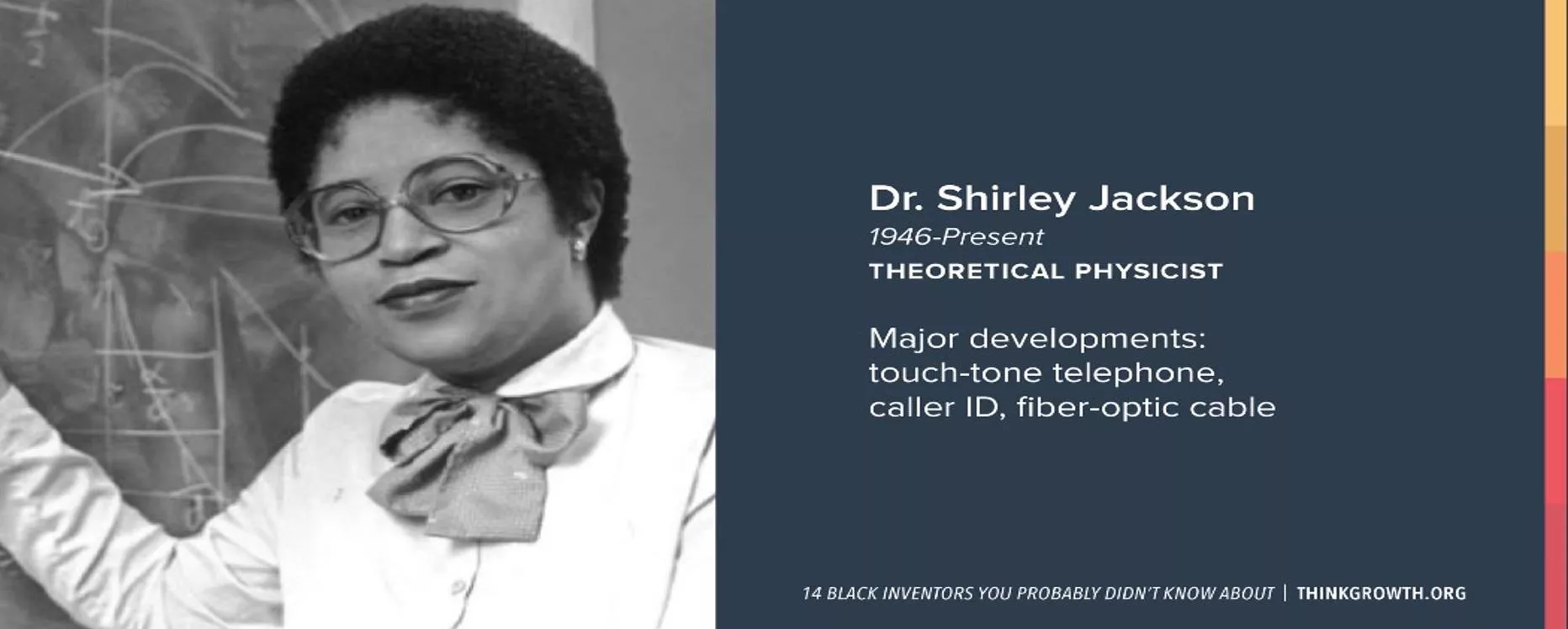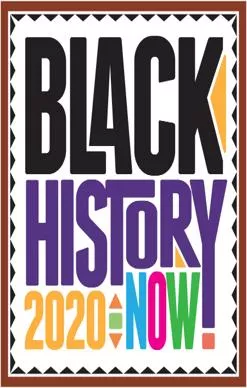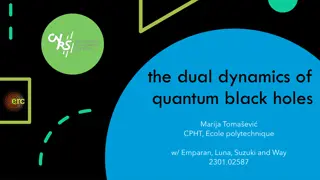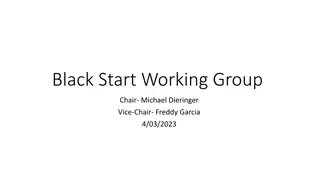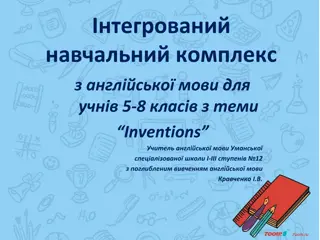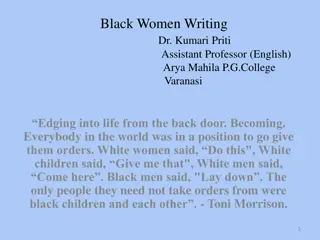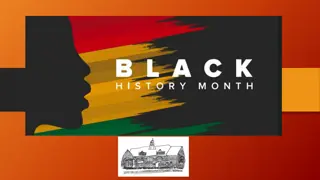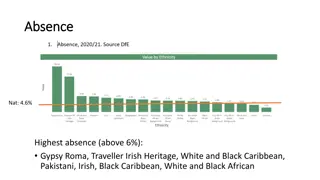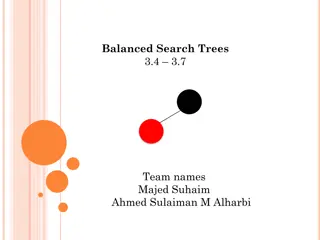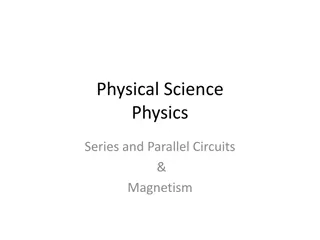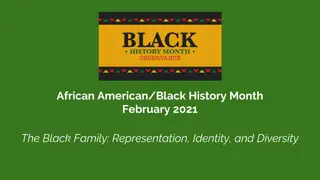Celebrating Black Inventors: Trailblazers in Science and Technology
Dr. Shirley Jackson, Otis Boykin, Lewis Latimer, Marie Van Brittan Brown, and Lonnie Johnson are celebrated Black inventors who have made significant contributions to science and technology. From pioneering advancements in nuclear physics, telecommunications, pacemakers, light bulbs, home security systems, to creating iconic inventions like the Super Soaker water gun, these remarkable individuals have left a lasting impact on society with their ingenuity and innovation.
Download Presentation

Please find below an Image/Link to download the presentation.
The content on the website is provided AS IS for your information and personal use only. It may not be sold, licensed, or shared on other websites without obtaining consent from the author. Download presentation by click this link. If you encounter any issues during the download, it is possible that the publisher has removed the file from their server.
E N D
Presentation Transcript
Dr. Shirley Jackson is an American physicist who received her Ph.D. from the Massachusetts Institute of Technology in 1973. She was the first African-American woman to earn a doctorate in nuclear physics at MIT. In addition to her lengthy list of academic achievements, she also has an impressive number of inventions under her belt. Her experiments with theoretical physics paved the way for numerous developments in the telecommunication space including the touch-tone telephone, the portable fax, caller ID, call waiting, and the fiber-optic cable. Today, Dr. Shirley Jackson is the 18th president of Rensselaer Polytechnic Institute in Troy, New York.
Otis Boykins most notable contribution to science was likely the circuit improvements he made to pacemakers after losing his mother to heart failure a contribution that has saved countless lives since. But this single improvement was among a long list of achievements. Boykin had 26 patents in his name and is famed for the development of IBM computers, burglar-proof cash register, chemical air filters, and an electronic resistor used in controlled missiles and other devices.
Inventor and engineer Lewis Latimer was born in Chelsea, Massachusetts, on September 4, 1848. He collaborated with science greats Hiram Maxim and Thomas Edison. One of Latimer s greatest inventions was the carbon filament, a vital component of the light bulb. His inventions didn t stop there, working with Alexander Graham Bell, Latimer helped draft the patent for Bell s design of the telephone. This genius also designed an improved railroad car bathroom and an early air conditioning unit. So the next time you re escaping a hot day inside your cool house, don t forget to thank Lewis Latimer.
Did you know that the first home security system was invented by a Black nurse? Meet Marie Van Brittan Brown. Although she was a full-time nurse, she recognized the security threats to her home and devised a system that would alert her of strangers at her door and contact relevant authorities as quickly as possible. Her original invention consisted of peepholes, a camera, monitors, and a two-way microphone. The finishing touch was an alarm button that, when pressed, would immediately contact the police. Her patent laid the groundwork for the modern closed-circuit television system that is widely used for surveillance, home security systems, push-button alarm triggers, crime prevention, and traffic monitoring.
Did you ever enjoy water gun fights as a kid? Well, meet Lonnie Johnson, the man that gave us the most famous water gun the Super Soaker. Lonnie wasn t a toymaker, he was actually an Aerospace Engineer for NASA with a resume boasting a stint with the US Air Force, work on the Galileo Jupiter probe and Mars Observer project, and more than 40 patents. Yes, he is also working on the Johnson Thermoelectric Energy Converter (JTEC) which converts heat directly into electricity but it s the squirt gun he created that has given us all the most joy.
Drew was a physician, surgeon, and medical researcher who worked with a team at Red Cross on groundbreaking discoveries around blood transfusions. In World War II, he played a major role in developing the first large-scale blood banks and blood plasma programs. He also invented the, and get ready because this name is pretty charming bloodmobiles. These are the refrigerated trucks that, to this day, safely transport stored blood to the location where it is needed most. Drew was one of the most prominent doctors working in his field, and one of the only African-Americans, during a time when blood donation was still separated along lines of race. Drew eventually resigned from his position with the American Red Cross over their insistence on adhering to this policy. It was 1950 before the Red Cross finally recognized all blood as being equal.
In 2013, Marian Croak was inducted into Women in Technology Internationals hall of fame, a move that recognizes her remarkable achievements in tech. Croak holds over 135 patents, primarily in voice-over Internet protocol (VoIP), some in other areas. She has another 100 patents currently under review. Today, Marian is an SVP at AT&T, serves as a mentor for women in AT&T labs, and sits on the board for the Holocaust, Genocide and Human Rights Education Center.
Gelobter was integrally involved with the advent of Shockwave, a technology that formed the beginning of web animation. She also played a major role in the emergency of online video, later serving on the senior management team at Hulu. Previously, Lisa was the Interim Head of Digital for BET Networks and ran Technology, Product and Business Operations. Today, you can catch Lisa at the White House, in the United States Digital Service. She is currently serving as the Chief Digital Service Officer with the US Department of Education.
Due to cost, Philip Emeagwali was forced to drop out of school at age 14. But this didnt stop him from becoming one of the greatest computer pioneers of our time. In fact, he s often called The Bill Gates of Africa. As an adult, Emeagwali began studying nature, specifically bees. The construction of the honeycombed inspired him to rethink computer processing. In 1989, he put this idea to work, using 65,000 processes to invent the world s first super computer able to perform 3.1 billion calculations per second.
Jesse Ernest Wilkins, Jr. is one of the most important contemporary mathematicians. At 13, he became the University of Chicago s youngest student. Wilkins continued his studies there, earning bachelor, master, and eventually earning his doctorate degree in mathematics at the age of 19. He s published papers in mathematics, optics, and nuclear engineering. As a mathematician for the American Optical Company in Buffalo, N.Y., he perfected lens design for microscopes and ophthalmologic uses. His greatest contribution to scholarship was the development of mathematical models to explain gamma radiation and his work on developing a shielding against gamma radiation. His other claim to fame came from working on the Manhattan Project. At the Manhattan Project, Wilkins worked with future Nobel laureate Eugene Wigner and made significant contributions to nuclear-reactor physics, now known as the Wilkins effect and the Wigner-Wilkins spectrum.
Often regarded as one of the most famous black inventors ever, McCoy was credited for 50 inventions over the span of his career. In an effort to improve efficiency and eliminate the frequent stopping necessary for lubrication of trains, McCoy devised a method of automating the task. In 1872 he developed a lubricatingcup that could automatically drip oil when and where needed vital in avoiding sticking to the track. The lubricating cup met with enormous success and orders for it came in from railroad companies all over the country. It was so popular that when other inventors attempted to steal his idea and sell their own versions of the device, companies were not fooled. They insisted on the authentic device, calling it the Real McCoy.
Those who survived either of the World Wars thanks to a gas mask have Garrett Morgan to thank. Morgan first created the safetyhood to help firefighters navigate smokey buildings, later modifying it to carry its own air supply making it the world s first effective gas masks. He also had the good sense to add a third position to the traffic signal yes, there was a time when traffic signals just said indicated stop or go an addition that further reduced automobile accidents.
Mary and her sister Mildred patented many practical inventions. They didnt have technical education, but they were both exceptional at spotting ways to make peoples lives better. Together, they invented the sanitary belt. Later, Mary invented the moisture-resistant pocket for the belt. While disabled from multiple sclerosis, Mary went on to invent the walker and the toilet-tissue holder.
If your refrigerator has any produce from your local grocery store, then you can credit African-American inventor Frederick McKinley Jones. Jones took out more than 60 patents throughout his life, including a patent for the roof-mounted cooling system that s used to refrigerate goods on trucks during extended transportation in the mid-1930s. He received a patent for his invention in 1940, and co-founded the U.S. Thermo Control Company, later known as Thermo King. FREDRICK MCKINLEY JONES 1940 The company was critical during World War II, helping to preserve blood, food and supplies during the war. Invented Refrigerated Trucks
The use of elevators in everyday life keeps people from committing to long and gruelling climbs up several flights of stairs. However, before the creation of elevator doors that close automatically, riding a lift was both complicated and risky. Before automatic doors, people had to manually shut both the shaft and elevator doors before riding. Forgetting to do so led to multiple accidents as people fell down elevator shafts. When the daughter of African-American inventor Alexander Miles almost fatally fell down the shaft, he took it upon himself to develop a solution. In 1887 he took out a patent for a mechanism that automatically opens and closes elevator shaft doors and his designs are largely reflected in elevators used today. ALEXANDER MILES 1887 Invented Automatic Elevator Doors
Even for those who arent quick to pick up the mic during karaoke, microphones are used every day to communicate over distances far and wide. And more than 90 percent of the microphones used today, including the microphones used in phones and cameras, use a microphone co-invented by a black man. Dr. James E. West was tasked with creating a more sensitive and compact microphone while working at Bell Labs in 1960. Along with his German colleague Gerhard Sessler, West invented the foil electret microphone, which was considerably less expensive to produce than the typically used condenser microphones. Two years after it was invented, the final model of the microphone was developed and in 1964 they patented the landmark invention. Only four years later, the new microphone was in wide production was used in hearing aids, tape recorders, most telephones monitors. DR, JAMES E WEST 1964 Co-Invented Electret Microphone and baby
Before flat screens and hi-definition LCD monitors were the norm, PC computers with limited processing power. That all changed thanks to black inventor and engineer Mark Dean. Dean began working for IBM as a chief engineer in the early 1980s, making up a team of 12 people who would develop the first IBM PC. In addition to helping create IBM s original machine in his early years with the company, he also worked to develop the colour monitor and led the team that developed the first gigahertz processor. This massive chip, built in 1999, would allow for the higher processing rates at faster speeds within the PCs. MARK DEAN 1980 & 1999 Co-Invented Colour IBM PC Monitor and Gigahertz Chip
Carver was born a slave and was raised by his family's white masters. He was accepted into one college, but was turned away when he showed up for classes and the school's officials realized he was black. He would eventually become the first black student and the first black faculty member at what is now Iowa State University and went on to become a well-respected botanist. Carver developed techniques to improve soils depleted by repeated plantings of cotton. Together with other agricultural experts, he urged farmers to restore nitrogen to their soils by practicing systematic crop rotation: alternating cotton crops with plantings of sweet potatoes or legumes (such as peanuts, soybeans and cowpeas). These crops both restored nitrogen to the soil and were good for human consumption. GEORGE WASHINGTON CARVER C1864 - 1943 Scientist and Inventor
Entrepreneur, philanthropist, and activist, Madam C.J. Walker rose from poverty in to become one of the wealthiest African American women of her time. With only $1.25 to her name, she launched her own line of hair products and straighteners for African American women, MadamWalker s Wonderful Hair Grower. This product, as well as the Walker System' - a corporation dedicated employment opportunities for black women - made her the first African-American female millionaire. nationally-operating to MADAM C J WALKER 1867 - 1919 providing Invented Hair Growing Lotion
Patricia Bath was the first African American to complete a residency in ophthalmology and the first African American female doctor to receive a medical patent. In 1981, Bath began working on her most well-known invention: the Laserphaco Probe (1986). technology, the device created a less painful and more precise treatment of cataracts. Harnessing laser DR. PATRICIA E BATH 1942 - 2019 She also holds patents in Japan, Canada and Europe. With her Laserphaco Probe, Bath was able to help restore the sight of individuals who had been blind for more than 30 years. Invented Laserphaco Probe







